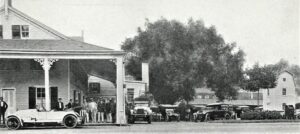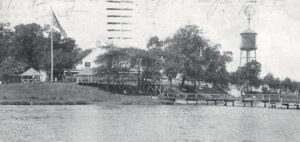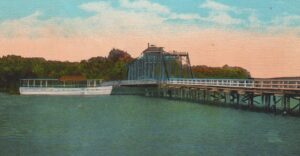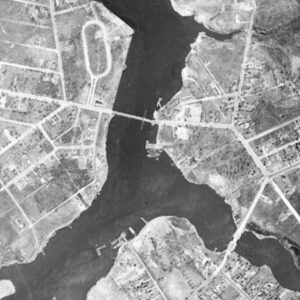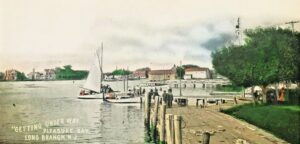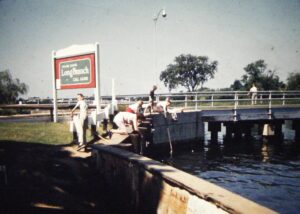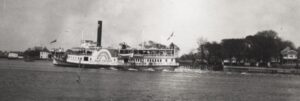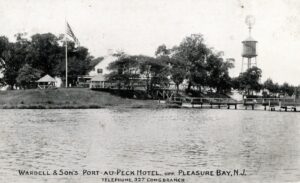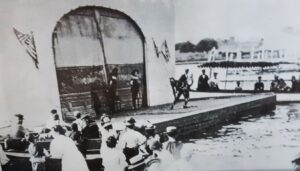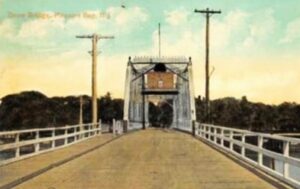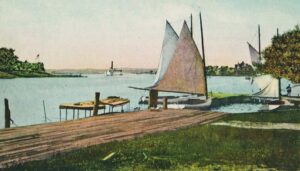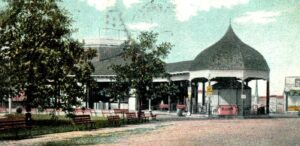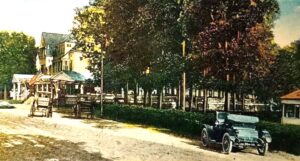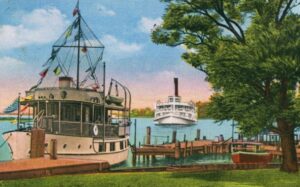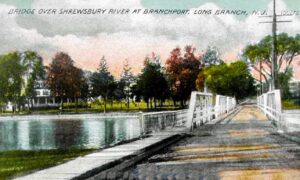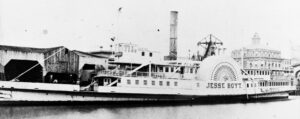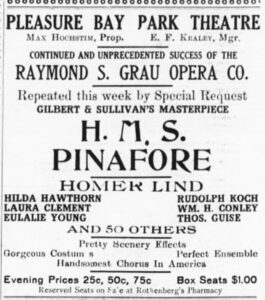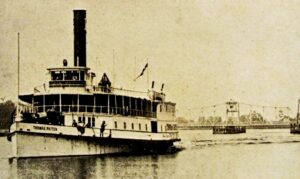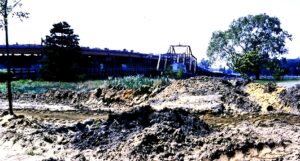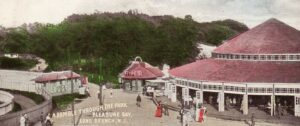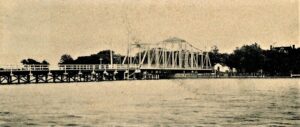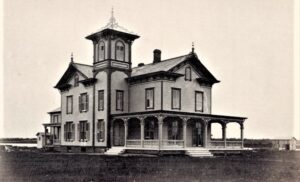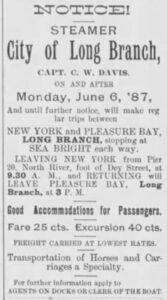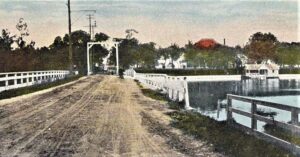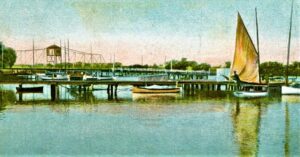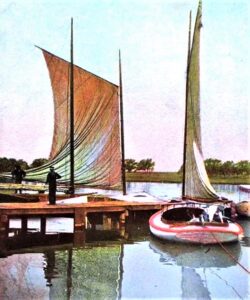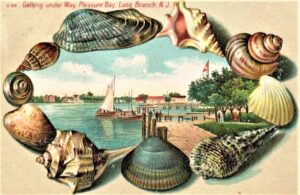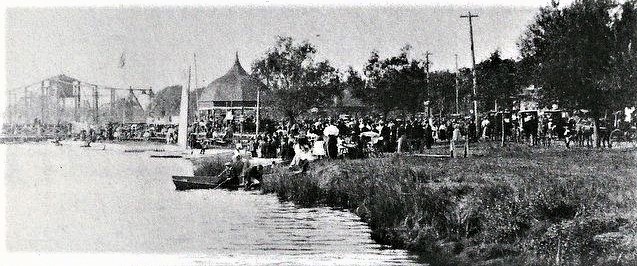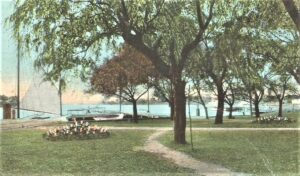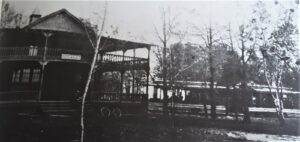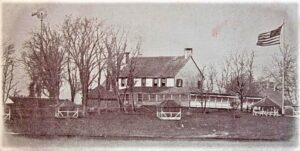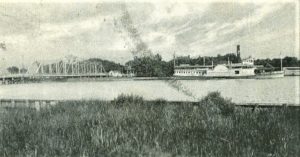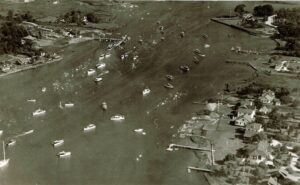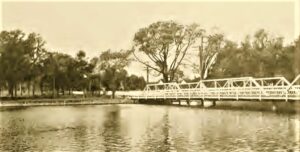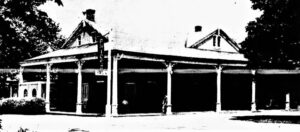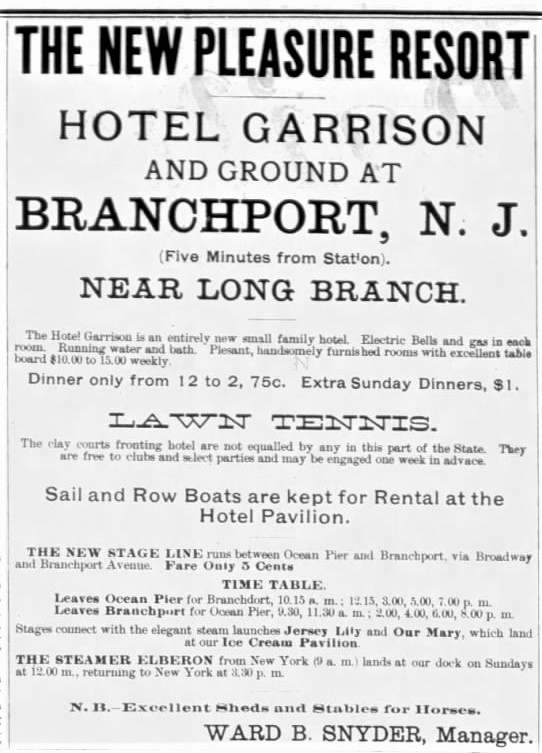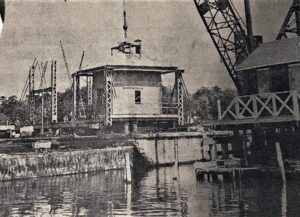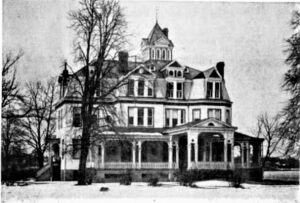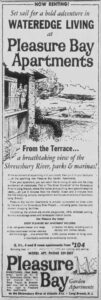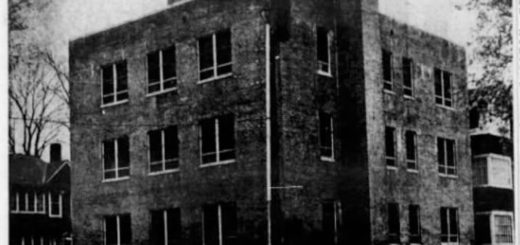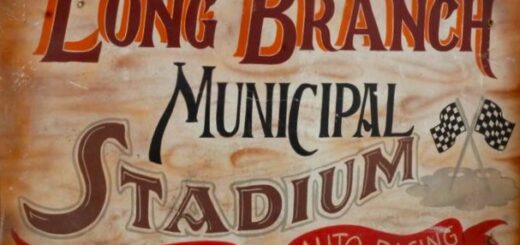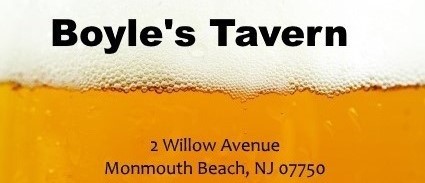Pleasure Bay Images …
In an effort to expand beyond the declining oceanfront hotel scene as the 20th century dawned, Long Branch developers turned their attention to a picturesque riverfront area — Pleasure Bay, a tributary of the Shrewsbury River. It would become “one of the most popular amusement centers on the Jersey coast.”
During glory times the location offered boating, bathing, fishing, lodging, fine dining, and entertainment. Clambakes and “shore dinners” were all the rage. By the late 1890s, Pleasure Bay Park had “champagne flow like the rippling waters of the Shrewsbury,” according to the Long Branch Daily Record.
“In the days when palatial steamboats plied between Long Branch and New York, Pleasure Bay was a place of distinction,” according to the 1941 Long Branch Daily Record. “A favorite gathering place for the elite of the land. The era’s celebrities sought relaxation and good food at the hotels operating there.” Patrons included Presidents Grant and Garfield, Jim Fisk, Jay Gould, Diamond Jim Brady, Hugh Hastings, George Pullman, A.J. Drexel, and Garret Hobart.
Access came by boat, trolley, train, steamship and later auto. In fact, with the passing of the steamboat era in the late 1920s, Pleasure Bay would lose its “life blood.” By the early 1940s, area waters were a “skeleton of its former glory.”
“Pleasure Bay has always been just what its name implies.”
—Long Branch Daily Record, July 1939
The oldest hotel on the Shrewsbury River — Price’s Hotel in Pleasure Bay — was established in 1854 by Captain Edward Hartshorne Price. The quaint 12-room hotel and restaurant were considered “the choicest spot in Jersey,” by the Long Branch Daily Record in 1937. Frequently referred to as “a historic Shore landmark,” everyone from presidents to industrialists to actors visited. Price’s wife Ann (West) helped run the business. She died in 1898; he passed in 1907. It was all wrecked by fire in November 1953.
The area’s Long Branch Ice Boat & Yacht Club was formed at Price’s Hotel in 1901. The Long Branch Steamboat Company (known as the Patten Line) acquired the 15-acre Pleasure Bay Park in 1919.
In rare turn Pleasure Bay mostly catered to middle class visitors, according to a July 1961 Long Branch Daily Record retrospective on the area — making it “one of the first to provide large scale amusements for any group but the wealthy.”
In June 1929, New York developer Frank Pergola, acquired 14 acres (the park land, Avenel Hotel, and surrounding area) from the Patten family estate. He ended up building 25 bungalows along the Shrewsbury River and also constructed area bulkheads and streets, but the Great Depression hit his interests hard.
Here is the photo-essay on Pleasure Bay. Enjoy:
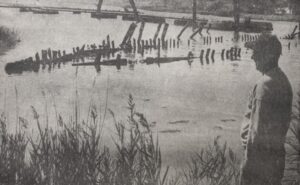
Remains of the SS Little Silver on Pleasure Bay, 1950s. The city acquired the 1893 Patten line steamship in 1938.
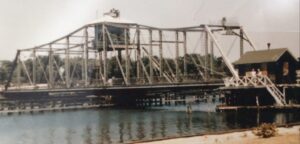
Old Pleasure Bay Bridge, 1940s. This old swing draw-bridge was replaced with a new 25-foot-high fixed span in September 1965.
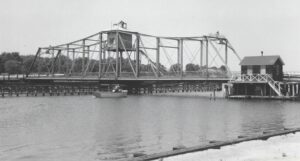
Pleasure Bay Bridge, June 1964. The overpass joins Monmouth Boulevard in Oceanport with Florence Avenue in Long Branch (Rosanne Letson Photo).
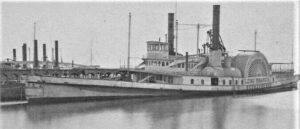
SS Long Branch docked at Pleasure Bay, 1890s. The beginnings of steamboat travel on the Shrewsbury and Navesink Rivers came date to a June 1819 New York Post ad — the business including 64 boats in total would operate for 111 years.
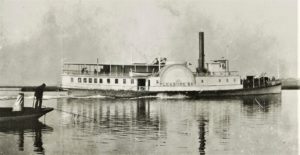
SS Pleasure Bay, early 1900s. The Long Branch Steamboat Company (known as the Patten Line) was organized by Thomas Patten, Sr. in 1890. The 120-foot-long boat was part of a small fleet that largely served Shrewsbury River and Pleasure Bay ports and offered trips to Battery Park in NYC. By 1938, steamships were done. Patten is credited with starting the nearby Pleasure Bay resort area in 1883.
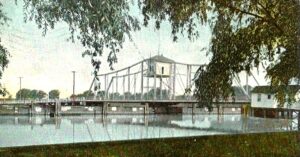
Pleasure Bay drawbridge, early 1900s. Opened in 1895, it joined Pleasure Bay with Port Au Peck in Oceanport.
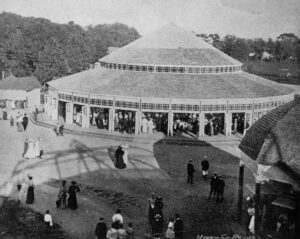
Grand Carousel at Pleasure Bay, 1911. Designed in 1897 by Charles Looff, who built the first Coney Island merry-go-round in 1876. Moved from Long Branch in 1910, ultimately the structure ended up at a Central Massachusetts amusement park until 2000.
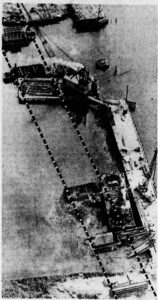
Pleasure Bay bridge under construction, October 1964. The Long Branch-Oceanfront span cost $1.3 million and was built by the Robert Bossert Company of Newark. It opened in September 1965 replacing the the old 1894 bridge.
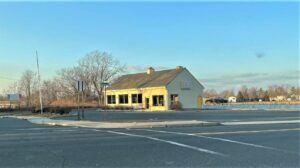
Alone by the water — a vacant building at the corner of Atlantic Avenue and Liberty Street along Troutman’s Creek. In years previous, it was a gas station and Long Branch Bait & Tackle shop (Claudia Giron Photo). The old Pleasure Bay spot cries out for quality development.
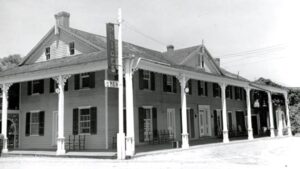
High Living — Price’s Hotel, 1940s. In operation before the Civil War, it burned in 1953. Owner Edward Hartshorne Price was born in Oceanport in May 1827. The Long Branch Daily Record called him “the best known summer hotel proprietor along the Jersey Coast from Sandy Hook to Cape May,” on his death in February 1907. The small but stylish 16-room hotel catered to the rich and famous (including four US presidents).

“Cats Meow” ad, 1975. Short stay — the location would became Casa Comida, a Mexican restaurant run by Paul and Kris Catlett in June 1985.
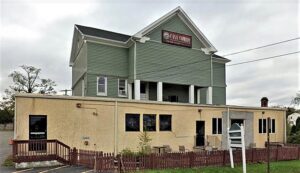
Casa Comida at the end of its long run, 2022. Very popular in its day, the Branchport Avenue eatery closed in Fall 2021 after 35 years of Mexican food service.
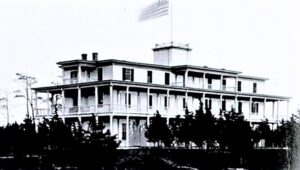
New York Hotel in Pleasure Bay. Built in 1867 off Branchport Creek, it could accommodate 100 guests and even had an observation deck. It became the Riverside House Hotel in 1873.
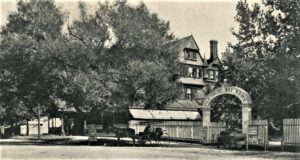
Entrance to Pleasure Bay Park on Atlantic Avenue, 1906. In 1919, the Long Branch Steamboat Company acquired the park its amusements and lodgings.
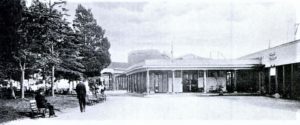
Pleasure Bay Park on Atlantic Avenue, 1905. At its peak time as a resort, the park had a trolley line, boat dock, floating theater for concerts and shows, amusement rides and picnic facilities. The area was once owned by George M. Harvey, a former US Ambassador to Great Britain.
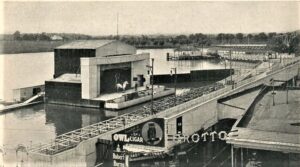
Orpheum Theatre at Pleasure Bay Park, 1906. It was an “open-air” stage along the riverfront. A summer ending “Water Carnival” that season drew 15,000+ spectators. There was also a Pleasure Bay Opera Company that performed here.
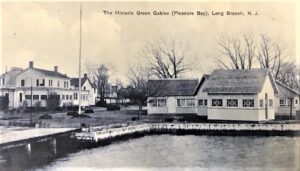
“Green Gables” Hotel at Pleasure Bay, 1920. Nicholas E. West opened the spot in 1880 and was a longtime owner. Joseph H. Hornung was a later owner.
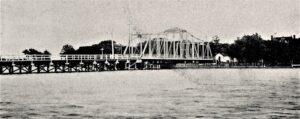
Old Pleasure Bay bridge, early 1900s. Opened in 1894, it was the last steam-powered swing bridge on the East Coast. The old bridge built by E.A. Young of Elizabeth cost $8,250; the new bridge built by Wittberg Construction cost $1.3 million.
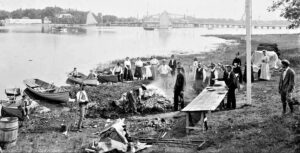
Clambake at Wardell’s Port-au-Peck Hotel, 1907. Pleasure Bay swing bridge in background. Clambakes were the hotel specialty.
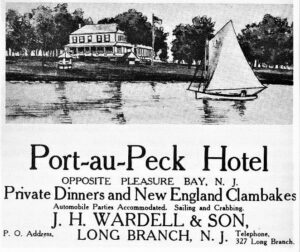
Wardell’s Port-au-Peck Hotel ad, early 1900s. Owner J. Herbert Wardell was born in Monmouth Beach in 1838 — everyone called him “Uncle Hub.”
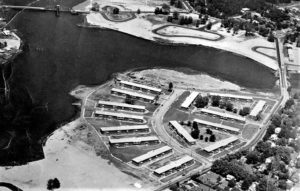
Pleasure Bay Apartments, 1966. Located at Atlantic Avenue and Liberty Street, when first opened in March 1964, it included 270 units in a “garden apartment community” (rents started at $104/month). Built on 30-acres along the river, Lionel K. Levy was the project architect; the developer was Atlantic-Shrewsbury Corp.
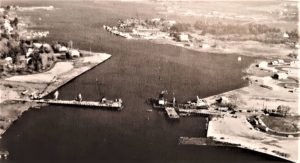
Pleasure Bay Bridge connecting Long Branch and Oceanport under construction. The new fixed-span bridge cost $1.3 million and opened in Sept. 1965.

